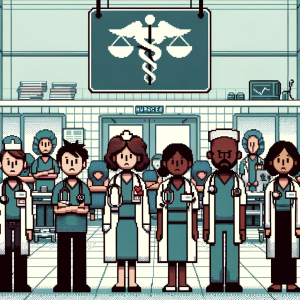
Gender-Based Violence in Healthcare
Imagine going to work every day knowing you might face verbal abuse, bullying, or even physical assault. For many healthcare workers worldwide, this is a harsh reality. A recent scoping review sheds light on the troubling prevalence of gender-based workplace violence (GB-WPV) in healthcare settings across the globe.
Unveiling the Reality
The healthcare sector, a pillar of compassion and care, ironically harbors an unsettling secret—workplace violence, especially gender-based violence. This review, comprising 226 studies, reveals the sobering truth: women in healthcare experience significantly higher rates of non-physical violence, including verbal abuse, sexual harassment, and bullying, compared to their male counterparts. Conversely, men are more frequently subjected to physical violence.
The Numbers Speak
The review meticulously analyzed studies from various countries and healthcare settings. Alarmingly, 64% of the studies reported a higher prevalence of all forms of violence against women. For example, in the USA, 91% of nurses reported experiencing workplace violence, with non-physical violence being the most common. In China, 72% of nurses faced similar issues. These statistics underscore a global epidemic that transcends borders and cultures.
Factors at Play
Several factors contribute to this grim scenario. Younger healthcare workers, those with less experience, those working in certain clinical settings (like emergency departments), and those holding lower professional status are more vulnerable to GB-WPV. Organizational hierarchies and gendered roles exacerbate these risks, reflecting structural disadvantages women face in the workplace.
A Closer Look: Case Studies
In Australia, female nurses in emergency departments and psychiatric units reported high levels of non-physical violence. Similarly, in Saudi Arabia, non-Saudi healthcare professionals, especially women, faced elevated risks of bullying and verbal abuse. These examples highlight the pervasive nature of GB-WPV and its impact on diverse healthcare settings.
The Broader Implications
The consequences of GB-WPV extend beyond individual suffering. They ripple through healthcare organizations and society at large. Women who experience such violence often report poorer mental health, job dissatisfaction, and a desire to leave their profession. This not only affects their careers but also compromises patient care and strains healthcare systems.
Moving Forward: Recommendations
Addressing GB-WPV requires a multi-faceted approach. The review emphasizes the need for systemic changes in clinical practice, academia, policy, and research. Here are some key recommendations:
- Policy and Regulation: Implement and enforce strict anti-violence policies in healthcare institutions. Regular audits and transparent reporting mechanisms are crucial.
- Training and Awareness: Educate healthcare workers about recognizing and responding to GB-WPV. Training should also focus on promoting gender sensitivity and equality.
- Support Systems: Establish robust support systems for victims, including counseling services and legal aid. Encourage a culture of reporting without fear of retaliation.
- Research and Data Collection: Continue research to understand the nuances of GB-WPV better. Comprehensive data collection will aid in developing targeted interventions.
Join the Conversation
We want to hear from you! Have you or someone you know experienced workplace violence in healthcare? How do you think healthcare institutions can better address this issue? Share your thoughts in the comments or on social media using the hashtag #HealthcareSafety.
Why It Matters
Understanding the dynamics of GB-WPV is crucial for public health practitioners and researchers. It impacts the well-being of healthcare workers and the quality of care patients receive. By addressing this issue head-on, we can create safer, more supportive work environments that benefit everyone.
Conclusion
The findings from this review are a stark reminder of the ongoing challenges within the healthcare sector. Gender-based violence is not just a personal issue—it’s a public health crisis that demands immediate attention and action. As we strive for universal health coverage and better healthcare systems, ensuring the safety and dignity of healthcare workers must be a top priority.
Join the Community – Get Your Weekly Public Health Update!
Be a health leader! Subscribe for free and share this blog to shape the future of public health together.



